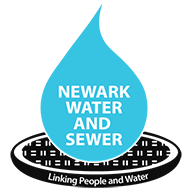How Newark is Using Advanced Free-Floating Technology to Inspect Aging Water Infrastructure
*This article is featured on Page 44 of the January/February 2025 Issue of the American Infrastructure Magazine.
Newark Water & Sewer personnel extracting the SmartBall (bottom center in green) at Branch Brook Park, August 21, 2024. Photo Credit: Newark Water & Sewer.
In the face of maintaining a complex network of water infrastructure, the City of Newark is making proactive strides to strengthen the water system for future generations.
Newark has tested the waters with AI-facilitated technologies in creating its vast lead service line inventory and in predicting disinfection byproducts after water treatment. The city is taking a step further in utilizing sophisticated technology for the inspection of aged water pipes.
Over 100 years ago, Newark conveyed its first water main distribution pipes to thousands of homes and businesses. Today, the city is home to about 1000 total miles of pipes that provide water and wastewater services to over 330,000 customers. That is a lot of infrastructure to maintain. To do this, the municipality continues to embark on forward-looking infrastructure projects to stay ahead of the curve.
Several water main breaks this year prompted Newark engineers to find new solutions to inspect water pipes before problems arise. The city is testing out new technologies that can tell us more about our pipes on a higher level by directly exploring the inside.
This past summer, the most recent technology explored was acoustic monitoring with Xylem’s SmartBall® free-floating device, which utilizes acoustic or sound waves to detect small leaks and gas pockets in pipes. In collaboration with Xylem engineers, Newark recently deployed the SmartBall at a 60-inch main pipe in a three-mile area of North Newark that had shown signs of damage earlier this year.
“You can perform pipe inspections without any water service interruptions”, said Zehra Karim, Supervising Engineer at the City of Newark. Such an advantage avoids service shut-offs, which would prove difficult during peak water demand in the summer season.
During the inspection, the SmartBall traversed at an average speed of 1.0 to 1.5 feet per second, sending pings at eight GPS tracking locations. In just over six hours, the SmartBall safely completed its journey and collected about four gigabytes of data on leak damage locations within the main. The device can detect leaks as small as a pinhole, which is useful for monitoring even the most minute damages.
After the inspection, the data is analyzed in part using AI-facilitated software and summarized in a comprehensive report that assesses the magnitude of damages found.
“The report will give us a better understanding of where we may perform leak repairs before it appears on the surface and causes more damage to surrounding utilities, roadways, or private properties”, says Ms. Karim, who led the effort in using the device for in-depth pipe inspection. Depending on the material of the water main, such as cast iron or steel, Newark can begin creating a repair plan.
“90% of the inspection is planning”, said Ms. Karim. Part of that planning is speaking to other water suppliers and nearby cities about the increased flow needed to move the SmartBall efficiently through the pipes. For instance, the neighboring city of Elizabeth, which is in part a Newark water customer, had to be notified of the flow being increased to 20 MGD, 35% more than a typical day’s flow.
“This inspection gave Newark a chance to collaborate with neighboring communities and their water supply managers to perform this inspection”, said Ms. Karim. With the success of this first trial, Newark can begin scheduling more pipe inspections across the city.
Another technology the municipality is exploring is Xylem’s PipeDiver® condition assessment platform, which pinpoints pipe wall loss, corrosion, cracks, and other indications of wall distress in greater detail using electromagnetic or ultrasonic data.
“If there are a significant number of leaks found in the pipeline, Newark may decide to perform a more in-depth leak assessment of the pipelines using the PipeDiver tool before any infrastructure repair strategy is planned”, Ms. Karim said.
Free-swimming technologies like these are precise and data-driven, which allows the utility to swiftly identify the work ahead on the path of reinforcing our water system.
Newark’s water infrastructure is a tremendous asset. It is a pipeline to thriving communities and the backbone of public health and the economy. As with any asset, it must be managed and taken care of — and Newark is doing that by leveraging the power of AI-facilitated technology.

